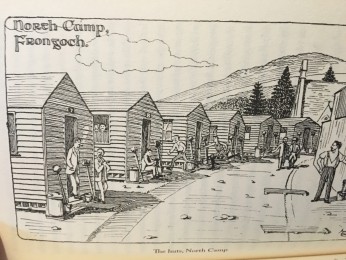
Kieran’s Our City, Our Town Article
Cork Independent, 26 May 2016
Remembering 1916, The Frongoch Deportations
Continuing on from last week’s column, replying to Mr Brian Dillon MP question on the internment of Irish volunteers post the Easter Rising, British Prime Minster Asquith in late May 1916 in Westminster stated that he would treat with the “utmost leniency and release as speedily as possible all persons except those who were concerned directly or indirectly with the rising and the preparations for it, and he also made an exception in the case of persons whose return to Ireland would be a source of danger to the peace of the country”. John Dillon MP, a member of the Irish Parliamentary Party, dominated proceedings in the House of Commons in London on the topic of the Easter Rising and the aftermath. Mr Dillon savaged the policy of the British government in Ireland, condemning in particular the executions of rebels, the holding of secret military trials, the continuation of martial law, and the wholesale searches and arrests being carried out across the country.
By 6 June 1916, the news of the prisoner deportations from Dublin had begun of one hundred prisoners (of eventually over 1800 prisoners) to prisons in such places as Wakefield, Wandsworth, and Knutsford Detention Barracks. Situated in Gwynedd in Wales, Frongoch was also an important detention barracks. The Frongoch Distillery had been founded by R Lloyd Price in 1897. However, by 1910 the enterprise had gone bankrupt and when war was declared against Germany in 1914 the old buildings were taken over as a prisoner of war camp. Several German prisoners died there and were buried in the village churchyard; their bodies were later disinterred and moved to other sites.
Following the Easter Rising it was decided that Frongoch as a remote location would be the ideal place to incarcerate the rebels. Journalist W J Brennan-Whitmore’s book, With the Irish in Frongoch, published in 1917, details that there were two parts to the camp. South Camp was located in the old distillery buildings, whereas North Camp was based in wooden huts a little higher up the hillside close to Capel Celyn. The two camps were connected by a road Conditions at Frongoch were difficult. The old whiskey distillery buildings were bitterly cold at night, very hot during the day, and the prisoners were plagued by an infestation of rats. Although the camp was guarded by soldiers, many locals worked there, in the kitchens and barrack blocks, and came into regular contact with the Irishmen.
Press opinion is editorials such those provided by the Cork Examiner in early June 1916 criticised the detention and deportation programme as not helping to bring about a compromise to the aftermath of the Easter Rising. The continued existence of martial law in Ireland enabled the military to act with absolute authority in such matters, but this was in variance with the various speeches of the Prime Minister Asquith who led the belief that a more “generous course of action could be pursued in connection with the persons under arrest”. Mr Asquith did not definitely commit himself to a promise that the Dublin prisoners or the prisoners detained in England would be forthwith released, but conveyed the desire as the Cork Examiner noted of “dealing in a humane and generous spirit with such prisoners, subject to certain exceptions”.
Mr Dillon responded positively to the announcement of the release of another batch of 200 prisoners, which was made by the military headquarters in early June 1916; “it is satisfactory as far as it goes, but the general opinion, which it may be said is growing more emphatic, is that this plan of release by instalments does not go far enough, and is not at all as effective, and cannot produce such beneficial results, both for Ireland and Great Britain”. The list included several southern names, but the Cork Examiner was quick to note that that many “Munster men are still incarcerated who took no active part in the recent disturbances, and their families, who have been left unprovided for, are naturally restless and discontented at the delay”.
Fast forward to 15 July and the Cork Examiner details that thirty–eight out of the several hundred prisoners ordered to be released from Frongoch internment camp arrived into Cork the previous day. They were mostly from the county, the greater number of them belonging to Macroom and the neighbouring districts. They left for their respective homes in the afternoon. During the evening others were arriving by the train getting into Cork at 8.35, and a number of sympathisers, headed by a couple of pipers playing national airs went to the Glanmire Station to meet them. The party then proceeded to the National Monument on the Grand Parade. It seemed as if they were about to hold a meeting, but whether this was so or not the police interfered and prevented any such taking place if intended. The party scattered into groups and disappeared in the side streets.
The camp at Frongoch was closed and the Irish prisoners discharged in December 1916. It had been a short lived experiment where the ideals of Irish Republicanism were established and strengthened rather than broken down.
Captions:
845a. Illustration of the huts, North Camp from W J Brennan-Whitmore’s book, With the Irish in Frongoch, first published in 1917; reprinted copies are available from Mercier Press, Cork.
845b. Illustration of the recreation inside the huts, from W J Brennan-Whitmore’s book, With the Irish in Frongoch, first published in 1917.
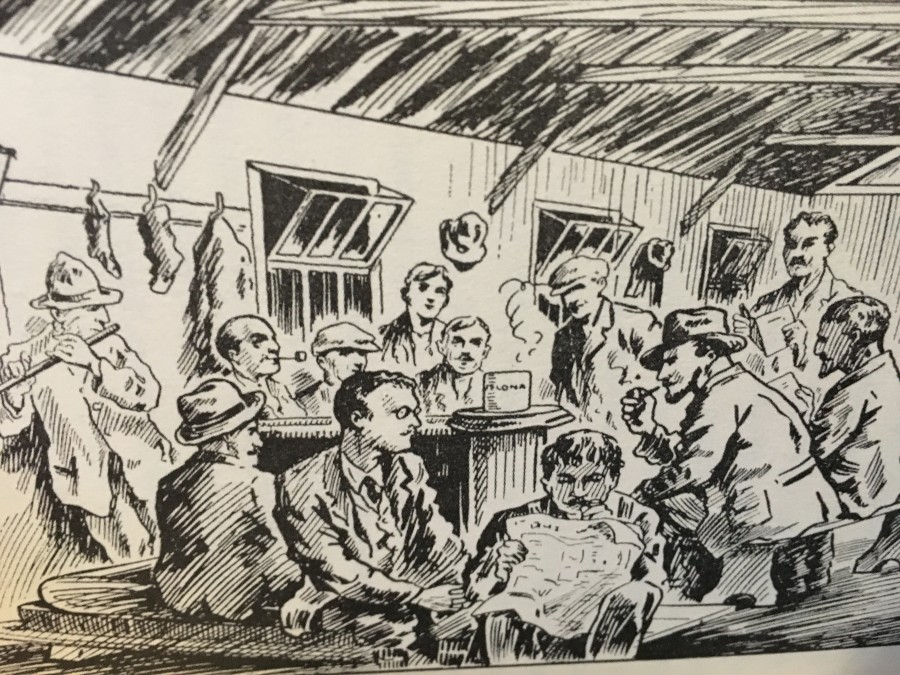
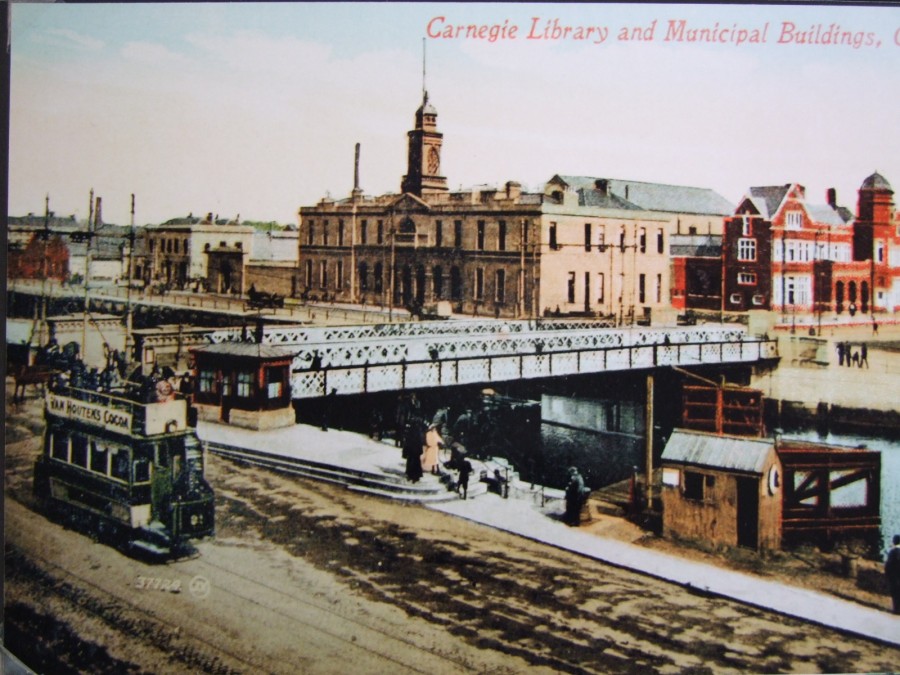
Kieran’s Our City, Our Town Article
Cork Independent, 19 May 2016
Remembering 1916, Asquith Comes to Cork
The imprisonment and executions of Irish Volunteers in May 1916 resonated across all classes of people. Exactly today one hundred years ago, Thursday 19 May – British Prime Minister Herbert Asquith paid a visit to Cork as part of his Irish tour of Rising hotspots. He arrived in Dublin on 12 May, almost three weeks after the Rising – there he stopped any further executions by General Maxwell. However, by then Irish public opinion had swung against him and Westminster.
Newspapers such as the Irish Independent and Cork Examiner describe the Cork visit. In the week of 12 May, it was taken for granted that he was coming to the south of the country with the aim of interviewing leading citizens and to ascertain for himself and first-hand the exact position of military affairs locally and regionally. Silence was displayed by those who knew of Mr Asquith’s movements, and when he would arrive in Cork, as well as the place where he would have his meetings with local political and policing leaders. It was not stated whether he would arrive by train or motor car. Many thought he would travel by train and hence many went to the Glanmire terminus to await the arrival of the 2.20pm train from Dublin. The train steamed in exactly to scheduled time, but the Prime Minister was not on it. A number of cross channel journalists who had been following Mr Asquith during his visit to Ireland alighted and it was ascertained that he was travelling down by motor car.
The hour of Asquith’s arrival was not known with certainty. He had, it was found, left Dublin somewhere about ten o’clock in the morning. At that time a motor-car would take five hours or more to negotiate the upwards of 160 miles. Putting two and two together, the journalists concluded that the distinguished visitor would reach Cork between three and four o’clock in the afternoon. Those who were set to receive and meet him professed not to know exactly when he would reach the city. It was discovered though that he intended to conduct his interviews at the Municipal Buildings or City Hall.
Just as the clock was showing five minutes to four a smart motor car came along via Parnell Bridge and unobserved drew up at the Municipal Buildings. The police in charge cleared a passage from the kerb to the steps of the buildings, and the Private Secretary, Mr Bonham Carter, was inside the vestibule before very many citizens were aware that he had reached the city. Here he was received by the Lord Mayor Thomas C Butterfield. The Prime Minister, evidently bent on business, was immediately conducted to the Lord Mayor’s Room. Here he chatted with Captain Dickie, the army official who dealt with the surrender of arms in Cork. The Premier next received Bishop Daniel Cohalan and a long discussion took place. Sir Henry O’Shea, ex-Lord Mayor, was then received. A deputation comprising of Captain D Sheehan MP, Alderman J C Forde, Mr David McDonnell and Mr Joseph Hosford, then awaited on the Prime Minister. The purpose of this deputation was not disclosed in the press, but after about fifteen minutes they withdrew. After this the City High sheriff, Councillor William Hart had a short interview with Mr Asquith; County Inspector Howe, RIC was next received, and after him Colonel Du Cros, and Lieutenant J F O’Riordan.
While the Prime Minister was at City Hall, the news that he was in Cork travelled rapidly. By the time Mr Asquith left the building at 6.25pm, a large crowd of citizens, of all classes and both sexes, gathered in the vestibule of City Hall and outside on Albert Quay. As he came down the stairs those in the balcony and vestibule raised cheers, which were taken up outside. He got into his motor-car and was driven to the Custom House Quay, where a steam launch was waiting to convey him down the river to Queenstown. The Prime Minister acknowledged the expressions of goodwill by raising his hat and bowing several times. On arrival at Queenstown, a steamer was placed at Mr Asquith’s disposal to convey him to Fishguard en route for London. Asquith remained tight-lipped on what he learned from his visit to Ireland. Ultimately he did not withdraw martial law. Weeks later he still claimed that Irish Home Rule could be best served after the war ceasing on the European continent. By the end of the year, due to the Irish and other military crises in his World War I campaign his political career was over as Lloyd George took over as Prime Minister.
Meanwhile further to the political discussion and the aftermath of the Easter Rising, some 1800 Irish men were interned at Frongoch internment camp at Frongoch in Merionethshire, Wales. It had been a makeshift place of imprisonment during the First World War. Until 1916 it housed German prisoners of war in an abandoned distillery and crude huts. In the wake of the 1916 Easter Rising in Dublin, the German prisoners were transferred and it was used as a place of internment for approximately 1,800 Irish prisoners, among them such notables as Michael Collins.
Captions:
844a. Cork City Hall, c.1916 (source: Cork City Museum)
844b. Lord Mayor of Cork, 1916, Thomas C Butterfield (source: Cork City Hall)
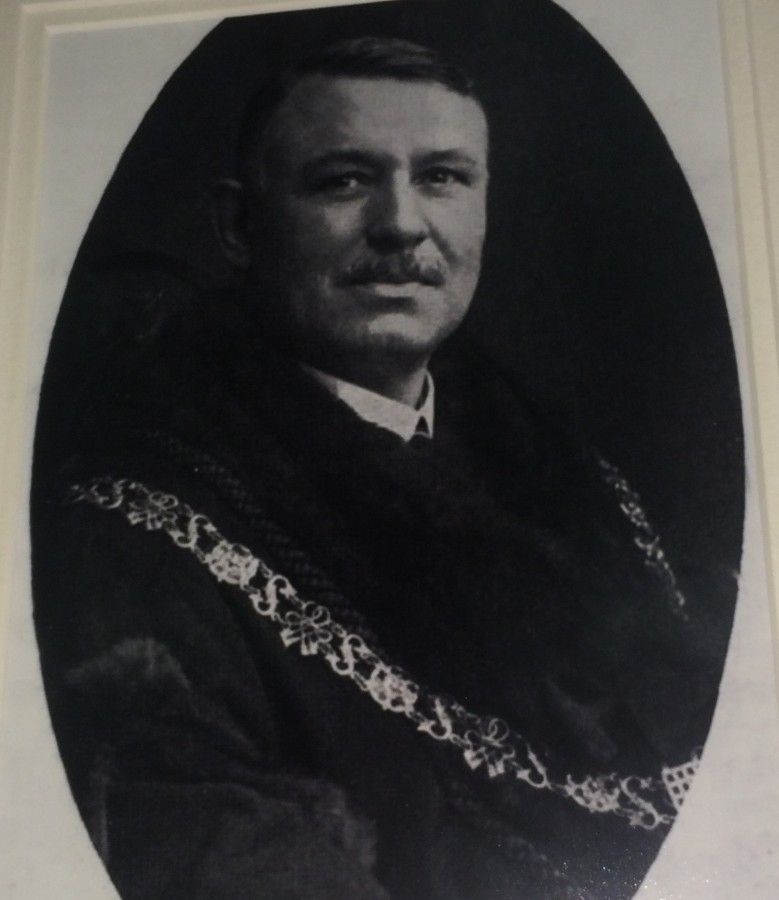
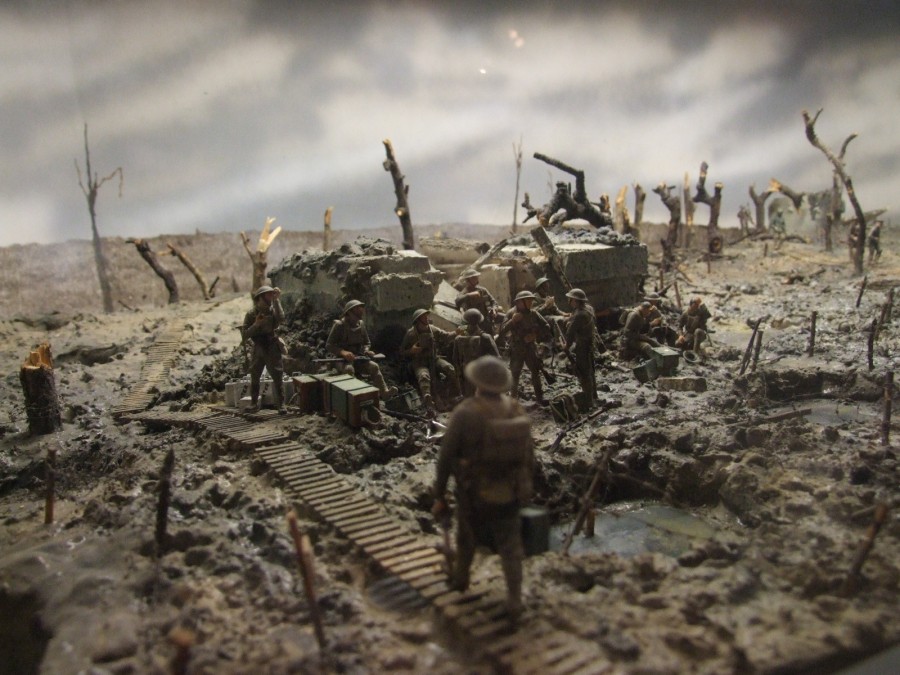
Kieran’s Our City, Our Town Article,
Cork Independent, 12 May 2016
Remembering 1916, The International Mood
Throughout 1916, pages and pages of writing and pictures are given throughout Irish newspapers to the tragedies of World War I. There are local Cork people shown in family photographs bound for the war. There are provocative death-ridden pictures of the front lines complete with descriptions of desolation and in depth geographical detail of hills, valleys and rivers spanning from France to Denmark. Views of the trenches, thousands of miles of scarred landscapes, blown up cities, collapsed road networks, burnt out homes, death at every corner – such images echo throughout the newspapers of 1916 and beyond, and stay in the mind long after you have read about them – the trenches are almost metaphors for the entrenched European society of the day – the allies and enemy not backing down – who will conquer? “Any day now it will end” – such remarks in editorials continuously work into the consciousness of the reader.
The political chessboard is active throughout the year with different perspectives and holding onto power. Physically European culture grasped Cork Harbour and the Irish channel as they became part of the battlefields of the seas and the fight for the Atlantic and North Sea. The torpedoed Lusitania of 1915 and the scuttled ship the Aud of 1916 haunted such maritime spaces – the presence of the other, the unknown enemy – in a submarine – waiting to take its chance and maim, sitting there on the ocean bed.
The daily published lists of deaths and the honours bestowed on participants glorify and construct a raison d’être for being on the front line. The naming of dead Corkmen and the families they left behind – the quests by the soul of city to be part of it – whether it was through the thousands of tons of Lambkins tobacco sent to the front line, to the picture shows of the war in the Palace Theatre and Cork Opera House – or even the regular flag days in support of the Red Cross and the Royal Munster Fusiliers (approx. 48 officers and over a 1,000 men). Then there were the conversations throughout the year about attaining a munitions factory for Cork – the empty shells almost standing in as metaphors for the empty promises of waiting for it – to provide jobs for those who did not go to fight on the masculine territory of the front line. The role of equality amongst the sexes features prominently – the men who went off to fight in the war versus the women in Cork who have stayed to put weaponry together, fundraise, volunteer at the Red Cross, engage in the quest for women’s votes, and in campaigning for women’s places as junior doctors in Cork hospitals – these are also discussion points as the year progresses.
On 18 May 1916, the Cork Examiner ran the story of the German placards placed on the front questioning the Irish holding the line in light of the 1916 rising. Private Dave O’Mahony, Macroom, attached to the Signal Corps of the Royal Munster Fusiliers, which formed part of the Irish Brigade, arrived home on leave from the trenches. Of the fighting generally, he noted it is of the “tricky kind, confined almost entirely to explosives. There is no open fighting, and that does not at all suit the men of the Munsters, who often long for an open hand-to-hand fight with the Germans”. Gas was the one death-dealing element they dreaded most. Just about Easter 1916, the gas attacks, which had ceased for a period of six months, were re-initiated by the Germans. The result of the attacks were disastrous; “It seems to me,” said Private O’Mahony, “that the Dublins and Inniskillings must have been caught unawares, because rats and mice, which are very prevalent, were to be seen turned up-side down, some of them quivering in their death agony”. When the wind is from a certain point all the men donned their masks, and at the first warning they pulled them over their faces to keep out the deadly fumes.
Private O’Mahony heard of the Dublin 1916 and deemed it a great shock to himself and his fellow comrades on the front. Things were unpleasant enough with the high casualty level around them. On one of those days the Germans placed out two boards on their parapet. One bore the news of General Townshend’s capture at Kut, with 30,000 men. Another had this query: ‘Irishmen, why will you fight for England while they are shooting your wives and sisters in Dublin’. Captain Larry Roche made up his mind that the ‘G’ Company should bring in these boards. He sent out some of his men, but the danger was too great, and they had to abandon their task. “Still there were men amongst the Munsters brave enough to take any risk, and who did the trick too. Lieutenant Biggane of Cork City and Corporal Kemp wrapped themselves in sheets of suitable hue, and crawling over the intervening space, with death hanging over them, they reached the enemy parapet and bore away, one each, the annoying placards”.
Captions:
843a. Model of World War 1 trench at Ypres World War 1 museum (picture: Kieran McCarthy)
843b. Former site of St Peter’s Market, Cornmarket Street; in 1916 it became a munitions factory (picture: Kieran McCarthy)
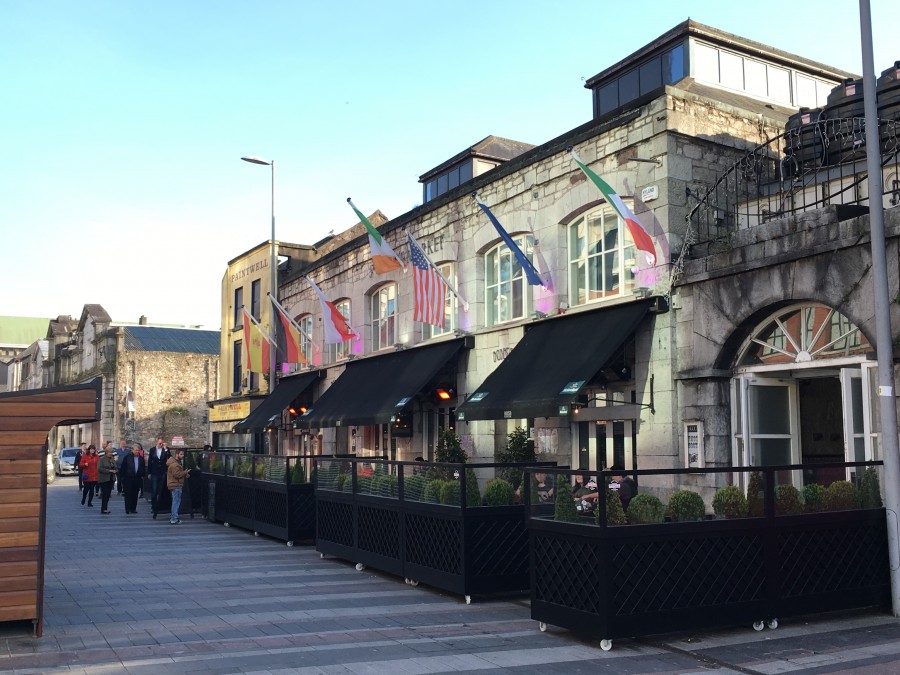
Cllr Kieran McCarthy invites all Cork young people to participate in the seventh year of McCarthy’s ‘Make a Model Boat Project’. All interested must make a model boat at home from recycled materials and bring it along for judging to Cork’s Atlantic Pond on Sunday 12 June 2016, 2pm. The event is being run in association with Meitheal Mara and the Cork Harbour Festival. There are three categories, two for primary and one for secondary students. The theme is ‘Cork Harbour Boats’, which is open to interpretation. There are prizes for best models and the event is free to enter. Cllr McCarthy, who is heading up the event, noted “I am encouraging creation, innovation and imagination amongst our young people, which are important traits for all of us to develop”. In addition, Cllr McCarthy emphasises that places like the Atlantic Pond are an important part of Cork’s natural and amenity heritage. For further information and to take part, please sign up at www.corkharbourfestival.com.
The Cork Harbour Festival will bring together the City, County and Harbour agencies and authorities. It connects our city and coastal communities. Combining the Ocean to City Race and Cork Harbour Open Day, there are over 50 different events in the festival for people to enjoy – both on land and on water. The festival begins the June Bank Holiday Saturday, 4th June, with the 28km flagship race Ocean to City – An Rás Mór. Join thousands of other visitors and watch the hundreds of participants race from Crosshaven to Douglas to Cork City in a spectacular flotilla. Cllr McCarthy noted: “During the festival week embark on a journey to discover the beautiful Cork Harbour and enjoy free harbour tours, sailing tasters, open days at Spike Island and Fort Camden, and lots more; we need to link the city and the harbour more through branding and tourism. The geography and history of the second largest natural harbour in the world creates an enormous treasure trove, which we need to harness, celebrate and mind”.
To ask the CE for the most recent update on the resurfacing of Douglas Pool car-park and adjacent hill, and why the issue has gone on for a protracted time without resolution (Cllr Kieran McCarthy)
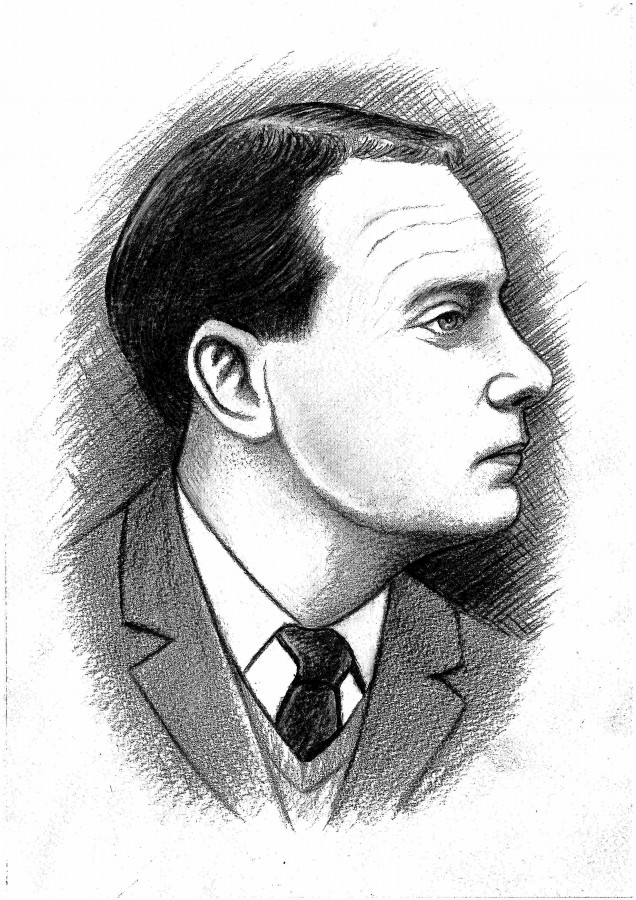
Kieran’s Our City, Our Town Article,
Cork Independent, 5 May 2016
Remembering the Executions, 1916
In the historic week that we have, it appropriate to remember the execution of the 16 people involved in the 1916 Rising. The Cork Examiner on Monday 1 May ran an article on the official surrender by Pádraig Pearse on the previous Saturday night. The short snippet read: “In order to prevent the further slaughter of unarmed people and in the hope of saving the lives of our followers, now surrounded and hopelessly outnumbered, the members of the Provisional Government present at Headquarters have agrees to an unconditional surrender, and the commanders of all units of the Republican Forces will order their followers to lay down their arms”. It was signed P H Pearse, dated 29th day of April, 1916.
General Maxwell declared martial law and gave the order to execute the 16. On 7 May, the newspaper detailed that Commandant Pearse had been shot dead on 3 May; “Patrick H Pearse, Commandant General of the Army of the Irish Republic, and President of the Provisional Government, was 36 years old. A member of the Irish Bar, and the Headmaster of St Enda’s School for Boys at Rathfarnham, Co. Dublin. He was born in Dublin, but was of English descent. After sentence of court-martial he was shot”.
On 8 May the Cork Examiner described in an editorial on the death toll of the Rising that although no official figures have been issued by the authorities; “it is known that the number of deaths of civilians caused in the recent revolt is considerable. Already no fewer than 160 have been accounted for, but the list which has been complied is by no means complete, as many dead bodies were not recognised in any of the places open to public inspection”. The 160 bodies they mentioned were made up of 112 male, 20 females, and 28 unidentified. During the previous few days many bodies had been buried in the Glasnevin cemetery. The previous day to the editorial no fewer than 60 being interred there during yesterday. In Mount Jerome there were also buried 25 civilians, 2 officers, 3 privates and a member of the Veterans Corps. Certificates of death from shot wounds were issued in respect of 150 cases. Owing to the shortage of labour the bodies have in many cases been interred coffinless, in their clothes, in sheets and in blankets.
In an editorial on 10 May, the editor argued for a ceasing to the executions; “Everything now is quiet throughout the country, and the stillness of death apparently hangs over our much-tried capital. Is it not time, therefore, that the putting into effect of the extreme penalty should cease, and that some effort was made in the future that the accused should be tried under circumstances which would provide that some idea of the accusations and the gravity of charges of those involved should be judged by the public? It is very widely believed that on a very small circle indeed the responsibility for this terrible occurrence rests.”
At a meeting of Cork Harbour Board: Mr D J Lucy presided. The chairman said that the previous week the board passed a resolution denouncing the late rising in Dublin; Speaking Mr Lucy said; “that as a sequel to their first resolution, and in keeping with their duty, they should yield to the side of clemency and Christian charity, and ask the Government to cease any further executions as sufficient had been done to expiate the offences of these foolish leaders in Dublin. The universal cry at the present, not only in Ireland, but in England, was that there should be an immediate cessation of the death penalty. He pointed out that such a course would not alone affect any bitterness that may remain, but may be entailed in the future. It would be in the interests of England to stop them for she had to look to the feelings of their kith and kin fighting England’s battle on the fields of France and elsewhere, and also the feelings of an important section of the population in America, who were watching these events”. He proposed that the board send a message to the Prime Minister Mr Asquith asking him to use his clemency, and to stop any further executions as sufficient has been done to atone for what had occurred.
The Assistant Bishop of Cork, the Lord Mayor of Cork, the City High Sheriff, and Messrs John J. Horgan, solicitor; George Crosbie, BL, James J McCabe, LLD, members of UIL, Cork City Executive, sent to the Lord Lieutenant, Mr Asquith, the Prime Minister, and Mr John E Redmond, MP, a telegram which declared that, voicing the opinion of the great majority of the citizens of Cork, they protested strongly against any further shootings as the result of court-martial trials, and against indiscriminate arrests throughout the country – that “Such shootings and arrests are having a most injurious effect on the feelings of the Irish people, and if persisted in may be extremely prejudicial to the peace and future harmony of Ireland, and seriously imperil the future friendly relations between Ireland and England”.
Captions:
842a. Pádraig Pearse (source: Cork City Library)
842b. Proclamation banner on display at this year’s Cork St Patrick’s Day Parade, 2016 (picture: Kieran McCarthy)
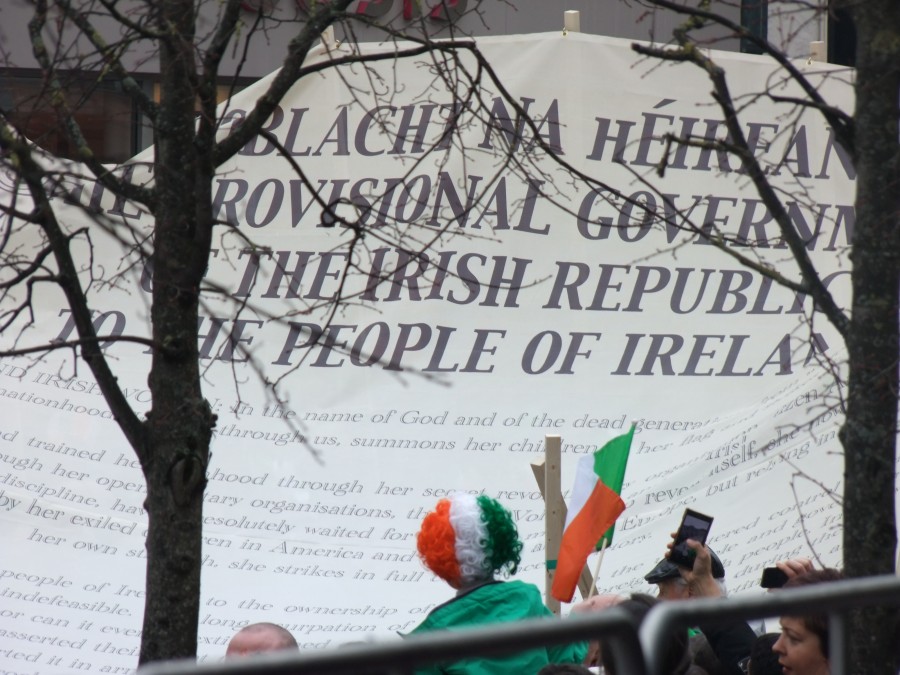
Cllr McCarthy’s Community Talent Competition 2016 Cork’s young people are invited to participate in the eighth year of Cllr Kieran’s McCarthy’s ‘Community Talent Competition’. The auditions will take place on Sunday 8 May between 10am-5pm in the Lifetime Lab, Lee Road. There are no entry fees and all talents are valid for consideration. The final will be held two weeks later. There are two categories, one for primary school children and one for secondary school students. Winners will be awarded a perpetual trophy and prize money of €150 (two by €150). The project is being organised and funded by Cllr Kieran McCarthy in association with Red Sandstone Varied Productions (RSVP).
Cllr McCarthy noted: “In its eight year, the talent competition is a community initiative. We generally get to audition people who have very little experience of performing. Within the audition process there is friendly feedback from our judges and if the auditionee gets through there are workshops to offer advice and support. The talent competition is all about encouraging young people to develop their talents and creative skills, to push forward with their lives and to embrace their community positively. I am delighted with the nuggets of talent that we have found in Cork communities over the years and very proud of those who post audition and competition, have taken up music, drama, and other elements of the performing arts within Cork – they engage with their talent and develop and enjoy it more”. Further details can be got from the talent show producer (RSVP), Yvonne Coughlan, 086 8764685 or email rsvpireland@gmail.com.
The birthday of Percy French is being marked in words and song by the Douglas Writers in Cork to co-incide with the publication of a new book on the famous entertainer. The Douglas Writers have now produced a DVD on Percy French and his link to the West Clare railway, made famous by his song Are You Right There Michael? Local author Billy MacCarthy from Shamrock Lawn, a lifelong fan of Percy French and a founder member of the Douglas Writers swops words for notes when he performs the song on the DVD. “The comic songs of Percy French are still enjoyed by many people and I hope the events in Douglas will introduce him to a new generation,” he said.
Cork city councillor and historian Kieran McCarthy will introduce the DVD in Douglas Library in the Douglas Village Shopping Centre on Saturday 7th May beginning at 11.30 am when he talks on the legacy of Percy French. Later at 8.30 pm in the Douglas GAA Hall, Ronnie McGinn hosts a Percy French Evening with showband star Art Supple and Friends. Tickets at five euro are now available from the Douglas Community Centre and the Douglas GAA Hall. All proceeds in aid of Douglas Meals on Wheels.







